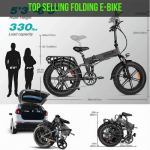Warning: Illegal string offset 'sponsored' in /home/balancingwheels.com/public_html/wp-content/plugins/show-affiliate-disclosure/show-affiliate-disclosure.php on line 50

Welcome to my world of e-bikes, the ultimate in personal freedom and convenience. Have you ever wondered if you can charge an e-bike while riding? Well wonder no further! I’m here as your expert guide to show you everything there is to know about charging your electric bike on the go.
It’s no surprise that more and more people are turning to electric bikes for their everyday commute needs – they’re fast, efficient, and a great way to get around without breaking a sweat. But what do you do when your battery runs low mid-ride? That’s where the ability to charge an e-bike while riding comes into play.
By understanding how batteries work and knowing which charging systems have been designed with this technology in mind, it’s possible to keep your ride going all day long. In this article, we’ll explore the ins and outs of how to charge an electric bike while you’re still pedaling away. So grab a cup of coffee or tea, settle back, and let me take you through the fundamentals of e-bike charging on the move!
Contents
Can You Charge an Ebike While Riding?
Power Sources for Electric Bikes
Powering an electric bike is like a puzzle there are many pieces that have to come together in order for it to work efficiently. E-bikes can be powered by several sources, including solar-powered batteries, battery-operated motors, and pedal-assist systems. Solar power has become increasingly popular as an alternative energy source and is the most sustainable option when powering your bike.
Battery-operated motors are usually more powerful than solar power but they require more frequent charging cycles since the battery will eventually run out of charge. Pedal assist systems are great for those who don’t want to expend too much effort while biking, as these systems provide extra torque with every push on the pedals. Hydrogen fuel cells offer another efficient way to power an e-bike as they produce zero emissions and are also very cost-effective compared to other methods.
No matter which method you choose, having access to reliable charging options is essential in keeping your e-bike running reliably at all times. Knowing how often your particular model needs recharging, along with choosing a convenient location for plugging in or replenishing hydrogen tanks, can help ensure a smooth ride no matter where the road takes you.
Advantages and Disadvantages of On-The-Go Charging
Charging an electric bike while riding is becoming increasingly popular, as riders seek the freedom of being able to charge their e-bike’s battery on the go. There are both advantages and disadvantages associated with this method of charging.
One advantage is that it provides a more portable solution for those who may not have access to a power outlet near where they’re riding. It also allows riders to save time by having their battery topped up while in transit, instead of needing to stop and plug into a wall socket. Additionally, it can be used as backup energy source if your main battery runs out of juice mid-ride.
On the downside, depending on how much you ride, it might take quite some time before enough electricity has been generated from your pedaling effort to make any significant difference in your battery level. Furthermore, depending on what type of charger you’re using and its wattage output capacity, continued use could potentially cause too much strain on the motor or even damage other parts of the bike over time due to high temperatures caused by prolonged periods of operation at maximum voltage levels.
Overall then, there are pros and cons when it comes to charging an e-bike while riding but ultimately each rider will need to assess which option works best for them based on their own individual needs and circumstances.
Conclusion
It’s an exciting time to be a part of the electric bike revolution. With more and more people looking for ways to reduce their carbon footprint, e-bikes are becoming increasingly popular. But when it comes to charging them while riding, there are some important considerations that need to be taken into account.
First off, it’s important to understand the different power sources available for electric bikes. There are three primary types: lithium batteries, lead acid batteries, and gas powered motors. Each has its own advantages and disadvantages in terms of range, cost, reliability and weight. Lead acid batteries have been around for decades but they can be heavy and require frequent recharging whereas lithium batteries offer increased range at a lower price point but may not last as long over time.
Finally, considering whether or not you can charge your e-bike while riding depends on what type of battery is powering it and where you’re able to find a reliable source of energy (such as solar panels). On average, riders who use a combination of both solar-powered chargers and traditional outlets will get approximately 3 hours of ride time per hour of charging making this an attractive option for those who want extended rides without worrying about running out of juice!


